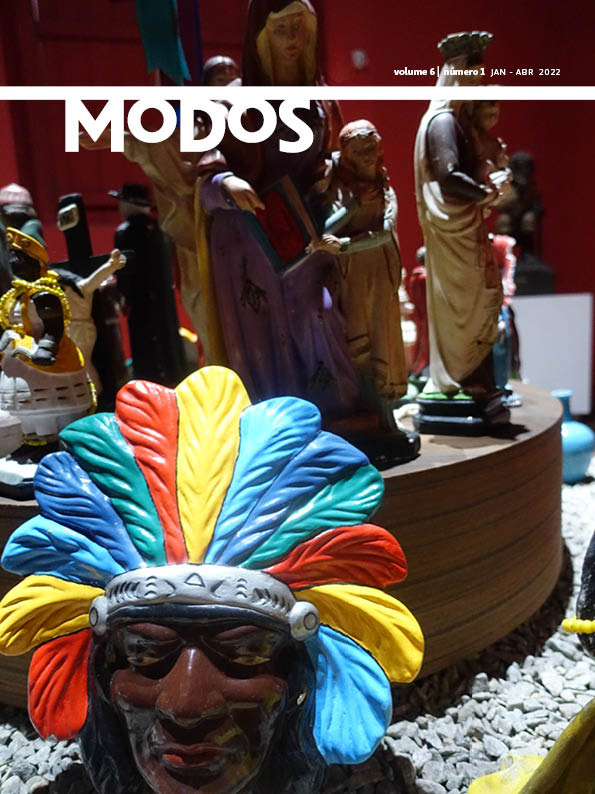Resumen
Este artículo se centra en los impactos emocionales de la estética en las religiones afrocubanas, con especial atención a las sesiones de consulta organizadas por especialistas en rituales de Palo Monte, Santería, Ifá y Espiritismo para resolver las dolencias de sus clientes. Demuestra cómo cada elemento del arte escénico ritual (marcos interactivos, estilos decorativos, aparatos materiales, instrumentos) conduce al cliente a un viaje emocional que constituye el poder efectivo de la sesión. Desde este ángulo, cada uno de estos cultos ofrece una configuración emocional única, una especie de firma afectiva que lo distingue inequívocamente de las demás modalidades religiosas agrupadas bajo la etiqueta de religión afrocubana. Una noción interesante en un momento en el que ciertos investigadores cuestionan el sentido de seguir estudiando estos cultos afrocubanos por separado, dada la porosa superposición entre ellos en términos de seguidores, conceptos y cosmologías compartidos ...
Citas
ARGYRIADIS, K. La Religion à la Havane. Paris: Archives Contemporaines, 1999.
DIESSNER, R.; GENTHÔS, R.; SIMMONS, H.; LYSNE, H.; ARTHUR, K. Altar-ing Aesthetic Emotions: Exploring Responses to Ecologically Valid Beauty Stimuli and Their Relationship to Trait Engagement With Beauty. Psychology of Aesthetics, Creativity, and the Arts, 2020. DOI: http://dx.doi.org/10.1037/aca0000368
ESPÍRITO SANTO, D. Spiritist boundary-work and the morality of materiality in Afro-Cuban religion. Journal of Material Culture, v. 15, n. 1, p. 64-82, 2010.
FINGERHUT, J.; PRINZ, J. Aesthetic Emotions Reconsidered. The Monist, 103, p. 223-239, 2020.
GOBIN, E. Un complexe sacerdotal cubain: les santeros, les babalaos et la réflexivité critique. Thèse de doctorat, Université Paris Ouest Nanterre La Défense, 2012.
HALLOY, A. Gods in the Flesh. Outline of an emotional learning process in the Xangô possession cult (Recife, Brazil). Ethnos, v. 77, n. 2, p. 177-202, 2012.
HALLOY, A. L’odeur de l’axé. Journal de la Société des américanistes, 104 (1), p. 117-148, 2018.
HANKS, W. F. Copresence and Alterity in Maya ritual practice. In: HANKS, W. F. Intertexts: writings on language, utterance, and context. Lanham, Rowman & Littlefield, 2001, p. 221-248.
HOUSEMAN, M. Comment comprendre l’esthétique affectée des cérémonies New Age et néopaïennes? Archives de sciences sociales des religions, 174, p. 213-237, 2016.
HOWES, D. The varieties of sensory experience. A sourcebook in the Anthropology of the senses. Toronto: University of Toronto Press, 1991.
HOWES, D. Sensual relations: Engaging the Senses in Culture and Social Theory. Ann Arbor: University of Michigan Press, 2003.
JAMES FIGAROLA, J. El principio de la representación múltiple. Del Caribe, v. 12, p. 19-32, 1988.
KERESTETZI, K. La maison aux esprits: configurations spatiales, pluralit religieuse et syncrétismes dans l’espace domestique afro-cubain. Journal de la société des américanistes, 104 (1), p. 75-116, 2018.
KERESTETZI, K. Making a nganga, begetting a god: materiality and belief in the Afro-Cuban religion of Palo Monte. Ricerche di storia sociale e religiosa, 87, 145-173, 2015.
KONEN, A. Rites divinatoires et initiatiques à La Havane: la main des dieux. Paris: L’Harmattan, 2009.
LÓPEZ VALDÉS, R. L. Componentes africanos en el etnos cubano. La Havana: Ciencias, 1985.
MEYER, B. Aesthetic Formations. Media, Religion and the Senses. Palgrave: New York, 2009.
MEYER, B. How to capture the ‘wow’: R. R. Marett’s notion of awe and the study of religion. Journal of the Royal Anthropological Institute, 22, p. 7-26, 2015.
PALMIÉ, S. Wizards & Scientists: explorations in Afro-Cuban modernity & tradition, Durham-London: Duke University Press, 2002.
PANAGIOTOPOULOS, A. The Island of Crossed Destinies : human and other-than-human perspectives in Afro-Cuban divination, Department of Social Anthropology, University of Edinburgh (Phd Dissertation), 2011.
PINK, S. Doing Sensory Ethnography, London/Los Angeles: Sage Publications, 2009.
PINNEY, C. Photos of the Gods. The printed image and political struggle in India. London: Reaktion, 2004.
RODAWAY, P. Sensuous Geographies: Body, Sens and Place. London: Routledge, 1994.
SILVIA, P. J. Emotional responses to art: From collation and arousal to cognition and emotion, Review of General Psychology, 9(4), p. 342-357, 2005.
SILVIA, P. J. Looking past pleasure: Anger, confusion, disgust, pride, surprise, and other unusual aesthetic emotions, Psychology of Aesthetics, Creativity, and the Arts, 3(1), p. 48-51, 2009.
STÉPANOFF, C. Dessins chamaniques et espace virtuel dans le chamanisme khakasse. Gradhiva, 17, p. 144-169, 2013.
STOLLER, P. The Taste of Ethnographic Things: the Senses in Anthropology, Philadelphia: University of Pennsylvania Press, 1989.
WIRTZ, K. Making sense of unintelligible messages in divine communication. Text & Talk, 27 (4), p. 435–462, 2007.
WIRTZ, K. Materializations of oricha voice through divinations in Cuban Santería. Journal de la société des américanistes, 104 (1), p. 149-17, 2018.

Esta obra está bajo una licencia internacional Creative Commons Atribución-NoComercial-CompartirIgual 4.0.
Derechos de autor 2022 Katerina Kerestetzi
